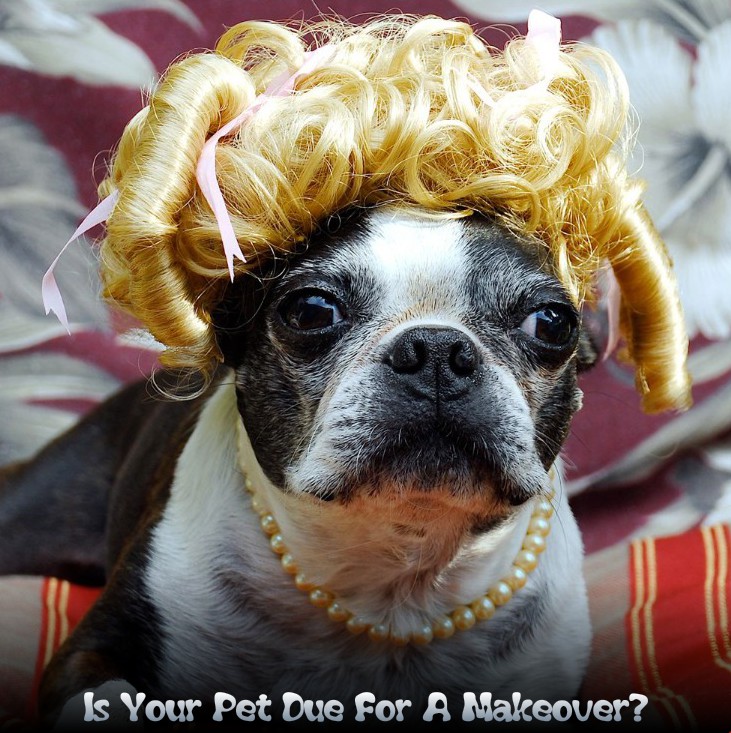Is your dog looking disheveled? Does your cat look less than cuddly? If so, a pet makeover is in order.
It’s amazing what a good hair styling, shampoo, conditioning and blow dry can do! Not only will your pet look and smell better, but he or she will feel better, too! You know how good you feel after a trip to the salon or spa! Why not do the same for your four-footed best friend?
Other than a few breeds that are supposed to have long shaggy hair, it’s easy to determine when your pet needs a makeover. Look for overgrown hair creating long bangs that obscure your pet’s vision. How about hair hanging from the tips of your pet’s ears? Are they collecting food and water as they dangle into his food and water bowls? Has your pet become sticky to the touch or developed an odor that makes Fido or Fluffy unhuggable?
In addition to the obvious cosmetic reasons for a makeover – there’s another good reason to treat your pet to a makeover – the emotional pick-me-up it offers. Even if your pet is not particularly dirty or unkempt, he or she can benefit from a makeover for purely emotional reasons. Good candidates for such a pick-me-up are adult pets who have been pushed into the background after their novelty has worn off, bored and lonely pets who are left alone all day, and pets that are depressed. Makeovers are beneficial for senior pets, particularly older cats who can no longer reach the areas they were once able to groom themselves.
THE TRIM
While makeovers can be performed by professional dog and cat groomers, we pet owners can do a lot ourselves at home. It’s not necessary to use an electric clipper, which requires a more experienced hand, but a good scissors made for hair cutting (generally available at pharmacies) can help any owner turn a scraggly pet into a real Prince Charming or Cinderella.
Hair hanging in front of your pet’s eyes can be trimmed away, but take care that the point of the scissors is directed away form the eyes. Leave a one or two inch ridge of hair above the eyes to act as an awning, providing some protection from direct sun. Ears can be freed from long hair fringes by neatly trimming around the outline of each ear, leaving an inch border. You can also follow the outline of the mouth and chin area to trim away extra beard hair which tends to become discolored and encrusted with food particles. Uneven hair under the belly can also be cleaned up with the scissors. So can excessive hair on the tail.
Also check the bottom of your pet’s feet for excess hair between the pads. Hair extending beyond the pads should be trimmed as grit and gravel often become entangled in the hair, creating sores between the pads. Speaking of feet, check the length of your pet’s nails. If you can hear them click as your pet walks across wood or tile floors, they’re too long. Long nails can cause lameness, aggravate arthritis and hip dysplasia because your pet’s weight is not properly distributed. So get your pet’s nail clipper and get to work.
THE BATH
If a bath is in order, be sure to use a shampoo made specifically for your type of pet. Don’t use dog shampoo on cats or vice versa. Take advantage of one of many special shampoos on the market. There are shampoos to brighten the coats of white-haired dogs and cats, to bring out the luster of black-coated pets, conditioners and detanglers for long-coated breeds, medicated ones for dry coats, just to name a few.
Before bathing, brush out all the knots in your pet’s coat. Be sure to protect your pet’s coat. Be sure to protect your pet’s ears from collecting water. This is done by placing a cotton ball with a dab of mineral oil into each ear – gently so it may be easily removed. Use a non-skid rubber mat on the bottom of the sink or tub, so your pet has secure footing. Follow the shampoo manufacturer’s label directions and be sure to rinse your pet well. Use care to dry your pet thoroughly.
A SPECIAL WORD TO CAT OWNERS
Cat owners, forget the age old thinking that cats don’t like baths and can’t be bathed! Show cats are bathed regularly. All cats should receive some assistance with their grooming. If started while young, your cat will become adjusted to it. If your cat is older, it’s best to introduce Kitty to bath time gradually. Whether young or old, play with your cat in the empty sink or bathtub. Give Kitty her favorite toys or treats. After a few play periods, when Kitty appears relaxed, repeat the process but place a very small layer of water in the bottom of the tub or sink.
Continue practicing the procedure a few times and when your pet seems comfortable, add a little more water, continuing this procedure until Kitty demonstrates that he or she has no fear of the tub, sink or water. Only then can a full bath take place. And, of course, while Kitty is adjusting to the bath time process, be sure to use plenty of praise.
Keeping up with your pet’s physical appearance is important, not only for the cosmetic improvement, but for emotional reasons, too. Of course your pet will be happier when annoying hair is removed, when his or feet don’t hurt, and he or she feels and smells fresh. But your pet will also feel good knowing that you cared enough to make him or her feel that way!



